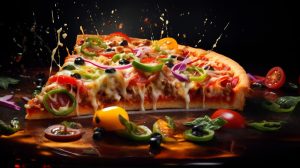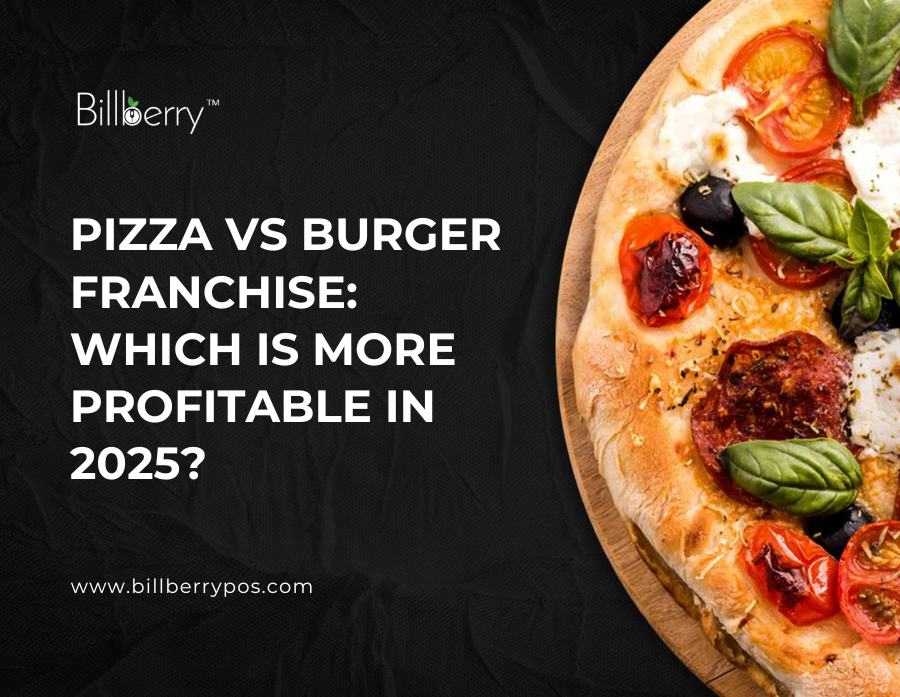Pizza or Burger franchise in 2026, compare growth, demand, ROI, and discover how Billberry POS helps run your QSR franchise efficiently.
The Battle of the Buns & Bases
The Indian food franchise landscape is sizzling with opportunity, and leading the charge are two fast-food giants: pizza and burger. Whether it’s a cheesy slice shared with friends or a juicy patty grabbed on the go, both options have captured the taste buds (and wallets) of millions across the country.
As the QSR (Quick Service Restaurant) industry continues to expand at lightning speed, many aspiring entrepreneurs, investors, and first-time food business owners are asking a crucial question:
Which franchise model is more profitable in 2026, Pizza or Burger?
In this blog, we’ll dive deep into both segments to compare their growth trends, profitability metrics, consumer behavior, and future potential, so you can make a smart, data-backed decision before starting your food franchise journey.
The Quick Service Restaurant (QSR) Boom in India
The QSR segment in India has been growing at a staggering rate of over 30% annually, and it shows no signs of slowing down. From metro cities to emerging Tier 2 and Tier 3 towns, the demand for affordable, fast, and delicious food options is fueling this growth across all corners of the country.
What is QSR?
Quick Service Restaurants (QSRs) are food outlets that serve ready-to-eat meals with minimal preparation time. These businesses rely heavily on speed, efficiency, and consistency, making them ideal for high footfall areas like malls, colleges, IT parks, and even highway food courts.
QSRs typically focus on:
~ Standardized menus
~ Fast service
~ Limited dine-in (or delivery-first) operations
~ Franchise-driven expansion models
Pizza & Burger: The QSR Giants
Within the QSR universe, pizza and burger categories together account for nearly 60% of the total market share, dominating consumer preferences in both metro cities and smaller towns. Their appeal lies in their versatility, affordability, and the ease with which they can be scaled through franchise models.
But between these two, which one is a smarter investment in 2025? Let’s break it down.
1. Pizza Segment in India: A Look at the Landscape

Demand & Popularity
Pizza is no longer considered just a Western indulgence in India, it’s become a weekend ritual for many families, students, and office-goers. Its image as a “sharing meal” makes it a go-to option for birthdays, celebrations, and casual meetups.
~ Gained strong cultural adoption in urban and metro cities.
~ Preferred as a group order, often shared among 2–4 people.
~ Appeals to all age groups, especially young adults and nuclear families.
~ Works well for dine-in, takeaway, and delivery models.
Market Size & Growth
The pizza market in India has seen stable year-on-year growth, driven by increasing disposable income, rising urbanization, and the growing food delivery ecosystem.
~ Current market size (2024–25): USD 5.3B to 7.3B.
~ Expected CAGR: 8–9% till 2033 — showing sustainable, long-term potential.
~ Growth driven more by Tier 2 and Tier 3 cities in recent years.
~ Innovation in menu (e.g., desi toppings) keeps brands relevant and competitive.
While it’s not a “hockey stick” growth curve anymore in metros, newer geographies and creative offerings are helping brands maintain momentum.
Investment & ROI Factors
~ Starting a pizza franchise often requires higher capital, primarily due to the kitchen setup and infrastructure needed.
~ Setup involves costly ovens, proofing cabinets, and prep stations.
~ Larger menu variety = more inventory and ingredient management.
~ Often requires more seating space, especially for dine-in models.
~ Slower table turnover compared to burger joints = fewer daily orders.
~ ROI takes longer unless paired with strong delivery or outlet location strategy.
That said, once established, AOV (Average Order Value) tends to be higher, a typical pizza order ranges from ₹500 to ₹1,000+, especially for groups.
Pros & Cons Summary
Pros:
✔️ Higher ticket size per order.
✔️ Strong appeal to urban audience and families.
✔️ Established systems and brand templates for franchisees.
✔️ Works well for party-sized and delivery-first formats.
Cons:
❌ Slower daily order churn due to dine-in focus.
❌ Higher initial investment (equipment + space).
❌ Heavy competition in urban areas.
❌ Margins often squeezed due to high delivery aggregator commissions.
2. Burger Segment in India: The Fast-Rising Competitor

Demand & Consumption Style
India’s burger culture is booming, not just because of global chains but also due to local brands and innovative startups. Burgers have become the go-to meal for solo diners and quick snackers, especially in urban areas.
~ Driven by India’s rising “on-the-go” eating habits.
~ Popular among Gen Z, college students, and office workers.
~ Often ordered as part of combo meals, adding sides, fries, and beverages.
~ Ideal for delivery and takeaway due to portability and low mess.
Unlike pizzas, burgers are rarely shared, which means more individual orders per day and faster inventory turnover.
Market Size & Growth
~ Burgers currently enjoy a larger share of the QSR pie than pizzas, and are growing at a much faster rate.
~ Burger segment accounts for 31% of India’s QSR market.
~ CAGR of 19–22%, significantly higher than pizza’s 8–9%.
~ Surge driven by Tier 2 & Tier 3 cities, with many regional burger brands popping up.
~ Premium burgers (plant-based, artisanal) are also gaining urban traction.
In short, burgers are not just fast food, they’re fast business.
Investment & ROI Factors
For franchisees, burgers offer a more budget-friendly entry point into the food business compared to pizza outlets.
~ Requires smaller kitchen setup = grills, fryers, cold storage.
~ Less need for dine-in space = smaller real estate costs.
~ Faster service model = more orders per hour/day.
~ Early breakeven potential: typically within 12–24 months.
~ Simple menu = easier training and operational efficiency.
This makes burger franchises attractive for first-time entrepreneurs and investors with limited capital.
Pros & Cons Summary
Pros:
✔️ Lower setup and operational costs.
✔️ Higher daily order volumes due to quick service.
✔️ Fast-growing demand, especially in small cities.
✔️ Easier to expand with smaller kiosk or cloud kitchen formats.
Cons:
❌ Lower average order value compared to pizzas.
❌ Can face identity issues, many brands feel similar.
❌ Heavily reliant on daily volumes for profit.
Comparative Analysis: Pizza vs Burger Franchise
When comparing both food segments side by side, some clear patterns emerge, especially when viewed through the lens of growth, cost, and scalability.
~ Market Share: As of 2026, burgers are leading the QSR battle slightly, commanding around 31% of the market, while pizzas hold a solid 28% share.
~ Growth Rate: Burger franchises are growing at nearly twice the pace, with a CAGR of 19–22%, compared to pizza’s 8–9%.
~ Average Order Value: Pizzas generally win here, with higher ticket sizes as they’re often ordered by families or groups. Burgers are more of a solo or quick-bite meal, leading to a lower per-order value.
~ Setup Costs: Starting a pizza outlet tends to be more capital-intensive, given the need for ovens, more diverse ingredients, and dine-in infrastructure. Burger setups, on the other hand, are leaner and cost-effective.
~ Break-even Timeline: Pizza franchises may take 18 to 36 months to break even. In contrast, burger outlets often see ROI within 12 to 24 months, thanks to faster service and lower investment.
~ Consumer Behavior: Pizza consumption is largely social and group-oriented, often reserved for weekend family meals or celebrations. Burgers serve the daily hustle, fast, filling, and convenient for solo eaters.
~ Expansion Potential: Pizza chains are seeing saturation in metros and Tier 1 cities. Burger brands, however, are rapidly expanding into Tier 2 and Tier 3 cities, capturing a broader consumer base.
Profitability Breakdown: What to Expect in 2025
Let’s talk numbers, not in tables, but in impact.
While pizza franchises offer a higher margin per order, this is often undercut by high setup costs, slower service speeds, and longer time to scale. Profitability is also more sensitive to location, and many urban areas are already oversaturated with pizza outlets.
Burger franchises, in contrast, may earn less per individual order, but the sheer volume of daily orders can quickly bridge that gap. The lower investment, faster turnover, and quicker breakeven point make them a smart option for new entrepreneurs or those looking for faster cash flow.
Plus, in an inflation-sensitive economy, burgers have an edge. Their combo-driven pricing, lower ingredient cost, and menu flexibility make them more resilient to price hikes, a critical advantage in 2026.
Which Franchise Should You Choose in 2025?
So, what’s the right path for you, the classic slice or the sizzling patty?
Choose Pizza If:
You’re entering a metro or Tier 1 city where dine-in culture thrives.
You have higher startup capital and want to build a premium or family-focused experience.
You’re looking to associate with international brands or wish to leverage strong loyalty among urban consumers.
Choose Burger If:
You’re looking for faster returns and leaner operations.
Your focus is on delivery, takeaway, or small-format outlets.
You’re targeting Tier 2 and Tier 3 cities, where affordability and speed drive orders.
But regardless of the path you pick, what truly defines success is how efficiently your franchise is run.
Why Operational Excellence Is the Real Gamechanger
Whether you’re flipping patties or stretching dough, the real challenge starts after the setup. Many franchisees underestimate how process bottlenecks, inventory mismanagement, or staff coordination issues can eat into profits.
And that’s where tools like Billberry POS become crucial, not just as software, but as a growth framework tailored for the QSR landscape.
Billberry POS: Powering Your Pizza or Burger Franchise
Running a pizza outlet? You’ll need to manage multiple ingredients per order, track bulk inventory, handle dine-in and delivery workflows, and ensure smooth kitchen coordination.
Operating a burger joint? Quick turnaround, high volume orders, and combo customizations can be a daily juggle.
Billberry POS simplifies all of that.
Here’s how it helps:
Real-time inventory tracking – never run out of cheese, buns, or ketchup again.
Multi-channel order management – accept dine-in, takeaway, or online orders seamlessly.
Centralized control – whether you run one outlet or 50, manage everything from a single dashboard.
Detailed eports & analytics – get clarity on what sells, when, and where.
Billberry isn’t just a POS, it’s a people + process framework built to support your journey from one outlet to a thriving QSR chain.
Final Thoughts: Pizza or Burger Franchise
There’s no one-size-fits-all winner between pizza and burgers. But one truth stands tall in 2026, efficiency and adaptability will define who thrives in India’s competitive QSR market.
So yes, pick your dish wisely. But also pick the right technology partner to support your hustle.
Book your FREE DEMO with Billberry POS, and see how it can transform your franchise journey, whichever side of the bun you land on.






